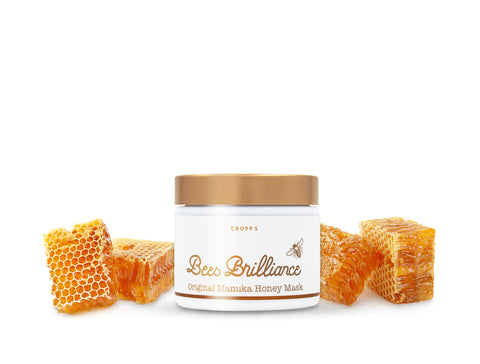Some of our most frequently asked questions are unsurprisingly about one of our star ingredients; Manuka honey. So we thought we'd de-bunk a few myths and get the scientifically supported facts out there...
What is Manuka honey?
Manuka honey is a unique and specific honey, native to Aotearoa (New Zealand). It comes from the bees that collect nectar from the manuka flower and has been shown to have powerful antibacterial properties.
What type of ingredient is it?
Antibacterial, as well as an anti-inflammatory and humectant (moisturiser).
Why is it used in skincare?
It can; aid in wound healing, draw in moisture to the skin, and can soothe skin conditions such as eczema and psoriasis.
Who can use it?
Anyone looking for hydrating and soothing benefits; manuka honey may also be beneficial for those with eczema and acne.
Can I just purchase supermarket honey and apply it directly to my face?
Skin that's healthy and intact has a slightly acidic pH range from 4.0 – 6.0. The pH of your skin is closely related to the overall health of your skin. If products are applied that disrupt or adversely affect the pH of your skin, this then has an impact on the skin barrier function and overall skin health.
Honey has a pH range between 3.2 – 4.5, when applied directly from the jar to your skin it could shift your pH skin environment to become too acidic. You might also be introducing pathogenic bacteria (if honey isn’t hygienically collected).
What's so special about the Bees Brilliance Manuka Honey Mask?
We've formulated our mask with 40% Manuka Honey, the honey has been tested for low moisture (to decrease risk of fermentation), Aerobic Plate Count (APC) for bacteria, Yeasts and Mould Count. Once the raw ingredient has passed our quality control standards, if it meets medical grade standard, we approve it and it is able to be safety added to our production batch.
The final production batch is then tested for pH. All our products are pH adjusted to sit between 4.0 – 6.0 so that aids the overall health of your skin balance.
What's a Manuka honey UMF, MGO or NPA rating?
We understand how very confusing Manuka honey has become, some companies say UMF, others say MGO, or NPA when indicating the quality of it in their products.
When we receive honey at the factory, it is sent to the laboratory, and tested for the following chemicals; Methylglyoxal (mg/kg) and Non-Peroxide Activity (NPA).
In New Zealand companies have created their own brand names for these very long and hard to pronounce chemicals tested at the laboratories. This is clever marketing, to help drive consumers to their brand but also makes it very confusing for the customer who just wants to know their honey is the genuine thing.
Examples...
MGO is a brand name for Methylglyoxal (mg/kg)
UMF is a brand name for Non-Peroxide Activity (NPA)
Both brands will have had the same laboratory tests performed on their batch of honey but they use a different name to indicate the same test.
Why don't we apply the MGO or UMF labels to our products?
We choose not to place another company’s trademark on the side of our packaging, instead all our Manuka honey is tested for either Methylglyoxal (mg/kg) and Non-Peroxide Activity (NPA). On the product label or box, you will find the word Mel (Manuka Honey), this is the INCI (International Nomenclature of Cosmetic Ingredients) name to identify Manuka Honey, as per the cosmetic industry standards.
All our Manuka Honey is tested for moisture content, hygiene (APC, Yeasts and Moulds) and has a minimum of 85 Methylglyoxal (mg/kg) or 5+ Non-Peroxide Activity (NPA) Activity.
Safety and high-quality are our biggest priorities - we want to make sure you know exactly what you're applying to your skin.


Comments (0)
Back to Stories